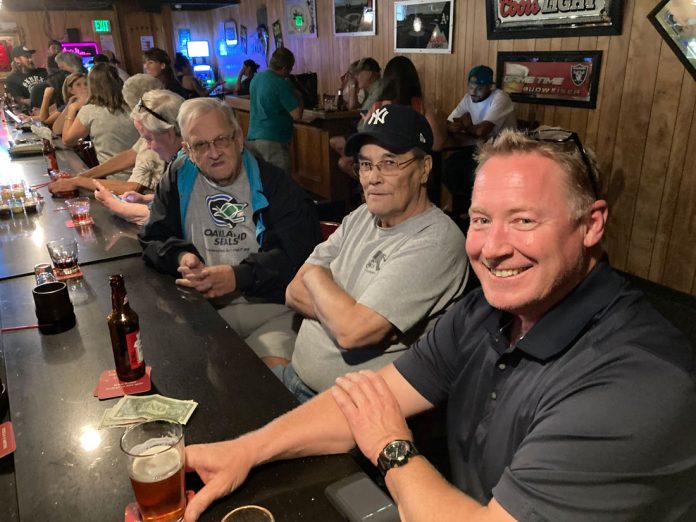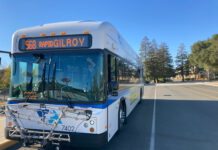
California’s long anticipated “reopening” of the economy on June 15 was met with crowded bars and busier restaurants. But state labor regulators, public health officials and local representatives are still in the process of clarifying mask guidelines and other public gathering practices.
The M&H Tavern in downtown Morgan Hill was a popular spot throughout the day Tuesday. The local bar—established in 1929—had been closed for more than 14 months because of the Covid-19 pandemic, starting with Santa Clara County’s first shelter-in-place order in March 2020.
The bar’s regular patrons were happy to be back at their favorite watering hole. No masks were seen among the thirsty crowd, social distancing was not a concern and no public health related capacity limits were in effect.
Longtime Tavern regulars Bill Legin and Mike Sibley, along with some friends, staked out a spot at the end of the bar early in the afternoon June 15. They expressed relief at finally being able to return to the bar to hang out with their friends, and commented that the atmosphere seemed like the Tavern had never even closed.
“The best thing is seeing a bunch of friends and seeing that they’re still healthy,” Sibley said.
Under the state’s Covid-19 risk assessment tier system and before vaccines were developed, indoor bars were considered one of the riskiest gathering places for the spread of the virus, and thus the last business sector to be permitted to reopen.
On June 15, Gov. Gavin Newsom and the California Department of Public Health eliminated the tier system, replacing it with a new “Beyond the Blueprint” guide for industries and business sectors.
Under the current guidelines, verification of Covid-19 vaccination or a negative test is required only for indoor “mega events” of 5,000 attendees or more. Such verification is recommended for outdoor mega events (10,000 or more people).
There are no statewide public health capacity limits or social distancing requirements for any indoor retail, dining or other business—including bars, movie theaters and family entertainment centers. Schools no longer have to enforce social distancing guidelines, according to the Santa Clara County Office of Education.
New mask rules
The updated rules on masks are somewhat more complicated as there are different sets of guidelines for the workplace and the general public. Under the current CDPH guidelines, masks are not required in public for fully vaccinated people except in the following settings: public transit, K-12 indoor schools, healthcare settings, correctional facilities, homeless shelters, emergency shelters and cooling centers.
Masks are still required for unvaccinated individuals in indoor public settings and businesses, according to CDPH.
It is unclear if or how public health officials or business owners would enforce the different requirements for vaccinated and unvaccinated individuals. Business owners are permitted to require all patrons to wear a mask, and implement vaccine verification efforts, according to the CDPH.
Masking rules in the workplace are determined by a different agency: California’s Division of Occupational Safety and Health (CalOSHA). The division’s board of directors on June 17 will consider updating the state’s workplace mask policies to align with CDPH and federal health guidelines. If CalOSHA approves the proposed workplace mask regulations, they will go into effect June 28.
Until then, employees of a business are still required to wear masks indoors until everyone in the workplace is vaccinated, according to CalOSHA.
The Morgan Hill Chamber of Commerce in recent days has been in the process of updating local businesses about the labyrinthine and quickly changing guidelines.
That process includes soliciting feedback from chamber members. Chamber CEO Brittney Sherman said in the results so far of a “post-pandemic recovery survey,” one of the biggest setbacks to fully reopening identified among Morgan Hill’s business community is the shortage of available workers to fill vacant positions.
“In the hospitality industry, they are desperate for workers,” Sherman said. “The workforce is just not there.”
Many former hospitality workers—let go by the thousands during the peak of the pandemic in 2020—are making more income through federal unemployment benefits than they would at their previous jobs. Those benefits are set to expire in September, and Sherman hopes there will be a “resurgence” in employment after that.
Board, council meetings
Local elected governing boards still have broad authority to set their own schedules for the return to public meetings.
The Morgan Hill City Council is currently planning to begin “hybrid” style meetings in September, according to City Clerk Michelle Bigelow. This would entail a combination of public, in-person attendees (including council members) inside council meeting chambers, with the continued availability of live, virtual viewing and participation for remote attendees.
Bigelow said the city will need to make some tech upgrades at council chambers in order to accommodate the hybrid meeting style.
“We want to ensure that when we are ready to have the community join the meetings, they will be efficient and engaging for those participating both in-person and virtually,” Bigelow said.
The Morgan Hill Unified School District Board of Education resumed in-person meetings for the first time at the June 1 meeting. Trustees and district staff were present in the board meeting room on Concord Circle, while the public remained in virtual attendance on Zoom.
Those in the boardroom during meetings, as of June 15, can remove their face masks if everyone in the room is vaccinated, said MHUSD spokeswoman Lanae Bays.
These MHUSD meeting policies will remain in place until further notice, Bays added.
“The Morgan Hill Unified School District Technology Team has provided the support to make these ‘hybrid’ meetings possible, in a similar fashion to our classroom set ups when we returned to in-person learning but there were still students at home who were attending the classes,” Bays said in an email to the Times.







